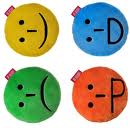 Internet TechNote February 18, 2009
The purpose is to confirm the humor/age link and to seek humor/personality link in order to support a patent application.
Internet TechNote February 18, 2009
The purpose is to confirm the humor/age link and to seek humor/personality link in order to support a patent application.
A humor appreciation internet survey with 40 humor lines and 20/50 Big 5 (B5) personality items ran for the span of 2008. The humor/age link of the previous survey was confirmed and evidence was found that humor scores are correlated mainly with the emotional stability factor of the B5, while cognitive scores (differential) are linked with the remaining four cognitive factors. The correlation coefficients were too small to show specifics of factor links it was thought hat this is due to the small number of participants.
An intuitive approach to the interpretation of humor is followed; the 4D classification was explained in terms of 4-types of animal aggressions: Self-preservation (emotional), feeding, sociosexual and rearing (parenting). Emotional humor reassures by either falsifying external threat to the immediate safety of the subject (externalized) or by falsifying the harm to the subject (internalized). Such threats are due to environmental external factors unrelated to internal motivational factors, therefore expected to be relatively constant over the life span of an individual and hence the preference is predicted to be constant. Feeding humor falsifies the intrusion threat to turf and resources, or the harm from losing the resources, and so on. Resource are needed most in order to grow to adulthood, the need tapers off with age and the prediction is that feeding humor starts high with adolescence and gradually falls. Sociosexual humor either discredits the sender of a sociosexual message or preserves the meaning despite a threat, sociosexual activity may be seen as peaking with female fertility at around age 30. And parenting humor is either anti-authority or self-defeating, and predicted as gradually rising in preference over age.
The added scores of humor lines for each motivational type were correlated with the B5 scores. The difference between externalized and internalized scores of each type were identified as the cognitive scores. An earlier TechNote suggested that B5 dimensions have a largely cognitive interpretation, correlating motivational and cognitive scores of humor with B5 would show whether the scores are linked following the similar meaning of interpretations.
The survey attracted a total of 479 participants and the data had a high reliability coefficient. The participants were divided by gender and six age groups. The first analysis sought the means and standard deviations of motivational and cognitive z-scores.
Appendix C shows the four age trends of male/female motivational/cognitive combination scores. Since the scores are not scaled no clear patterns are apparent, the data are included for future reference.
Apendix D contains the combined male/female motivational scores after scaling, the trends clearly agree with the predictions.
The second analysis is to investigate the link between humor appreciation and B5 scores. B5 came from two sets: 50 lines IPIP and mini 20 lines.
Appendix E shows correlation coefficients of both with motivation and cognitive humor scores. The individual motivational scores were added and the total was also correlated with the five personality scores. The cognitive and motivatioal humor scores showed only 3 correlation values larger than 0.1 with the mini 20 lines score, while the 50 lines scores has six with cognition and five with motivation, four are with the emotional stability scores as predicted. The link with emotional stability is obvious yet the values are not high enough to identify links between the remaining B5 and specific cognitive humor scores.




